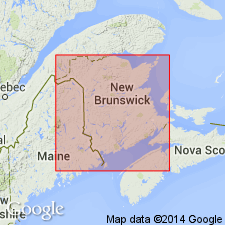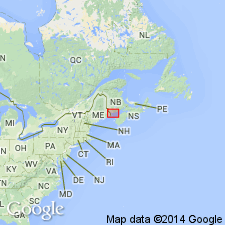
- Usage in publication:
-
- Waweig formation
- Modifications:
-
- Named
- Dominant lithology:
-
- Quartzite
- Graywacke
- Siltstone
- Argillite
Summary:
The Waweig Formation is here named for outcrops on the Waweig peninsula in Charlotte Co., NB, and includes sediments on the east and west shores of Oak Bay. It consists of gray, fine-grained, cherty quartzite and purplish graywacke, siltstone, and siliceous argillite. Faulting and lack of outcrop obscure the relationship to the underlying Dennis Formation; unconformably underlies the Oak Bay Formation. Age is Late Silurian based on fossils.
Source: GNU records (USGS DDS-6; Reston GNULEX).

- Usage in publication:
-
- Waweig Formation
- Modifications:
-
- Areal extent
- AAPG geologic province:
-
- New England province
Summary:
The Waweig Formation is here traced from the Wirral to the Calais area where it is truncated by Devonian plutons west of the St. Croix River in Maine. The Waweig here is composed of dense, fine-grained sandstone and siltstone of graywacke composition and nongraphitic slate. Transitionally overlies the Oak Bay Formation or unconformably overlies the Cookson Formation; interfingers with the partially equivalent Digdeguash Formation; grades upward into the overlying Flume Ridge Formation. Age is Early to Late Silurian (Llandoverian to Pridolian) based on brachiopods, cephalopods, corals, and other fossil fauna.
Source: GNU records (USGS DDS-6; Reston GNULEX).
For more information, please contact Nancy Stamm, Geologic Names Committee Secretary.
Asterisk (*) indicates published by U.S. Geological Survey authors.
"No current usage" (†) implies that a name has been abandoned or has fallen into disuse. Former usage and, if known, replacement name given in parentheses ( ).
Slash (/) indicates name conflicts with nomenclatural guidelines (CSN, 1933; ACSN, 1961, 1970; NACSN, 1983, 2005, 2021). May be explained within brackets ([ ]).

